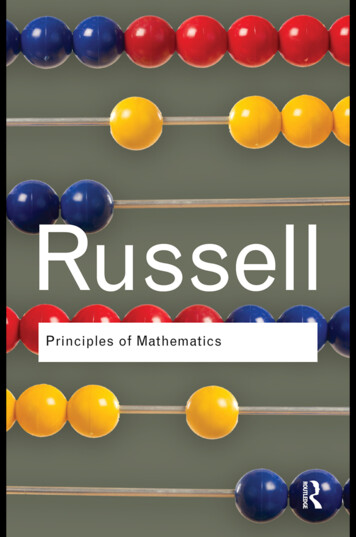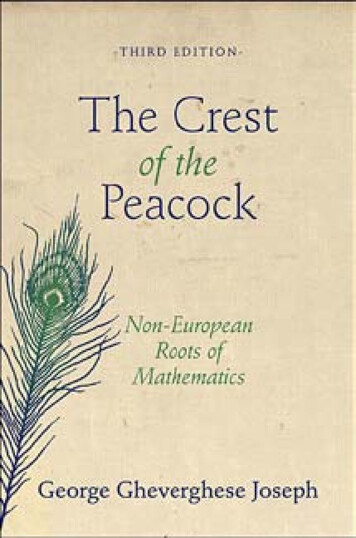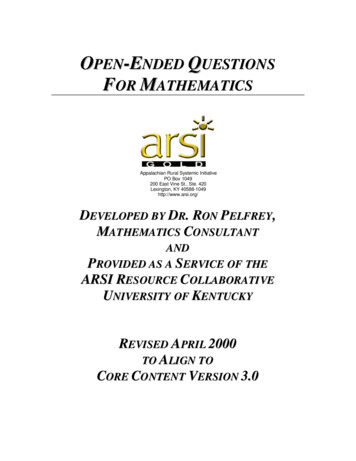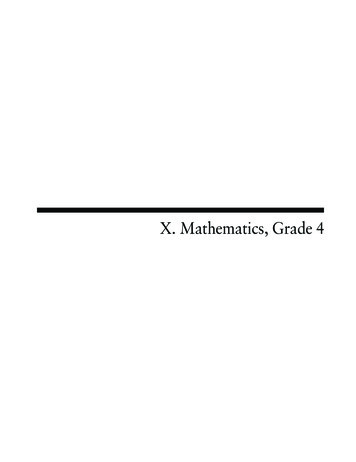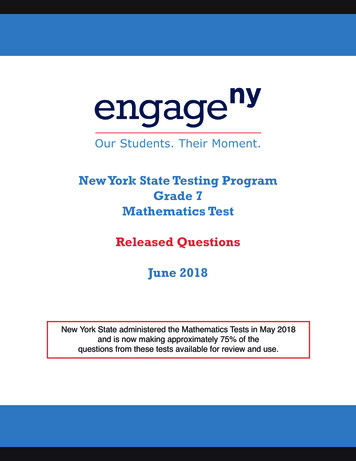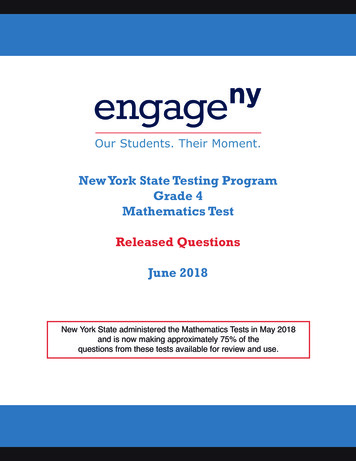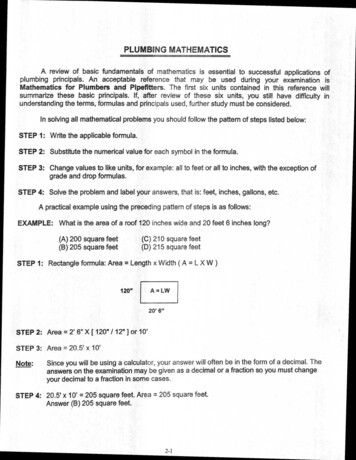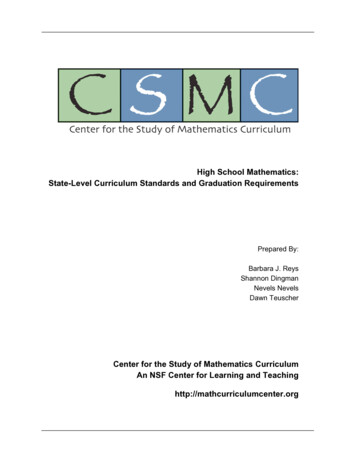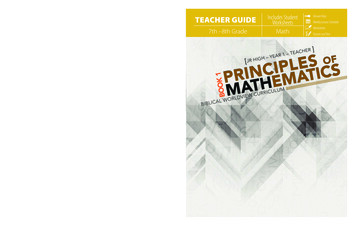
Transcription
TEACHERGUIDETeacher Guide for Book 1 of thePrinciples of Mathematics - Biblical WorldviewCurriculum for junior high!Math is a real-life tool that points us to God and helps us explore His creation, yet it often comes across as dry factsand meaningless rules. Here at last is a curriculum that has a biblical worldview integrated throughout the text andproblems, not just added as an afterthought. The resources in the Teacher Guide will help students master and applythe skills learned in the Student Textbook.BOOK 1What does this Teacher Guide include? Worksheets, Quizzes, and Tests: These perforated, three-hole punched pages help provide practice onthe principles taught in the main student textbook. Answer Keys: The answers are included for the worksheets, quizzes, and tests found in this TeacherGuide. Schedule: A suggested calendar schedule is provided for completing the material in one year, thoughthis can be adapted to meet individual student needs. There is also an accelerated schedule forcompleting the material in one semester.Are there any prerequisites for this course?This curriculum is aimed at grades 6-8, fitting into most math approaches the year or two years prior to startinghigh school algebra. If following traditional grade levels, Book 1 should be completed in grade 6 or 7, and Book 2 ingrade 7 or 8.[Book 1] Students should have a basic knowledge of arithmetic (basic arithmetic will be reviewed, but at a fastpace and while teaching problem-solving skills and a biblical worldview of math) and sufficient mental developmentto think through the concepts and examples given. Typically, anyone in sixth grade or higher should be prepared tobegin. The focus of the course is actually learning math for life, not simply preparing to pass a test.[Book 2] It is strongly recommended that students complete Book 1 course work before beginning Book 2 asmath builds on itself. Students don’t just learn how to manipulate numbers on paper, but starting with arithmeticand laying the groundwork for geometry and algebra (covered in Book 2), this curriculum both firms up thefoundational concepts and prepares students for upper-level math in a logical, step-by-step way that helps studentsunderstand concepts, build problem-solving skills, and see how different aspects of math connect.About the AuthorJUVENILE NONFICTION/Mathematics/GeneralRELIGION/Christian Education/Children & Youth 39.99 U.S.ISBN-13: 978-0-89051-991-2LOOPKatherine Loop is a homeschool graduate from Northern Virginia. Understanding the biblical worldview in mathmade a tremendous difference in her life and started her on a journey of researching and sharing on the topic. Forover a decade now, she’s been researching, writing, and speaking on math, along with other topics. Her books onmath and a biblical worldview have been used by various Christian colleges, homeschool groups, and individuals.TEACHER GUIDE7th –8th GradeIncludes StudentWorksheetsMathAnswer KeysWeekly Lesson ScheduleWorksheetsQuizzes and TestEAN
TEACHER GUIDE7th – 8th GradeIncludes StudentWorksheetsMathAnswer KeysWeekly Lesson ScheduleWorksheetsQuizzes & TestsPRINCIPLES OFMATHEMATICS BOOK 1First printing: August 2016MASTER BOOKSCurriculumCopyright 2015 by Master Books . All rights reserved. No part of this book maybe used or reproduced in any manner whatsoever without written permission of thepublisher, except in the case of brief quotations in articles and reviews.For information write:Master Books , P.O. Box 726, Green Forest, AR 72638Master Books is a division of the New Leaf Publishing Group, Inc.ISBN: 978-0-89051-991-2Unless otherwise noted, Scripture quotations are from the New King James Versionof the Bible.Please consider requesting that a copy of this volume be purchased by your local librarysystem.Printed in the United States of AmericaPlease visit our website for other great titles:www.masterbooks.comFor information regarding author interviews,please contact the publicity department at (870) 438-5288FaithrewoGrPermission is granted for copies of reproducible pages from this text to bemade for use within your own homeschooling family activities or for smallclassrooms of ten or fewer students. Material may not be posted online,distributed digitally, or made available as a download. Permission for anyother use of the material must be requested prior to use by email to thepublisher at nlp@newleafpress.net.
Problems from the Early 1900sHistory in math? Why not! Throughout the text, we’ve sprinkled in some math problems from history, often withsignificant adaptation. The sources are listed here for your reference. Feel free to look up the books and have fun withadditional problems:The following problems were adapted from Eugene Henry Barker, Applied Mathematics for Junior High Schools and HighSchools (Boston: Allyn and Bacon, 1920). Available on Google Books, http://books.google.com/books?id -t5EAAAAIAAJ&vq 3427&pg PR2#v onepage&q&f falseWorksheet 2.6, problem 5; Worksheet 4.1, problems 3, 4, and 5; Worksheet 4.5, problem 1; Worksheet 5.2, problem 6;Worksheet 5.7, problem 8; Worksheet 6.5, problem 3; Worksheet 8.2, problem 2b and 3; Worksheet 8.3, problems 5and 6; Worksheet 8.6, problems 3a and 3b; Worksheet 9.1, problem 8; Worksheet 14.3, problem 5; Worksheet 18.1B,problem 4a; Worksheet 18.4, problems 1e, 3a, and 3b; Worksheet 18.6, problem 3; Worksheet 21.1, problem 2a and 7;Worksheet 21.4B, problem 14; Quiz 3, problem 1; Quiz 6, problem 3a; Test 5; extra credit problemsThe following problems were adapted from John C. Stone and James F. Millis, A Secondary Arithmetic: Commercial andIndustrial for High, Industrial, Commercial, Normal Schools, and Academies (Boston: Benj. H. Sanborn & Co., 1908).Available on Google Books, http://books.google.com/books?id RtYGAAAAYAAJ&pg PP1#v onepage&q&f falseWorksheet 12.3, problem 3; Worksheet 12.6, problem 1; Worksheet 12.7, problem 4; Worksheet 12.8, problem 7;Worksheet 15.4, problem 4; Worksheet 16.4, problem 8; Worksheet 18.1B, problem 4b; Worksheet 18.2B, problems 2a and2b; Worksheet 18.3, problem 2a; Worksheet 18.5, problem 3; Worksheet 18.6, problem 4; Worksheet 21.2, problem 6This problem was adapted from Joseph Victor Collins, Practical Algebra: First Year Course (New York: American Book Co.,1910). Available on Google Books, http://google.com/books?id hNdHAAAAIAAJ&pg PP1#v onepage&q&f falseWorksheet 10.7, problem 2bSome problems are also adapted from Katherine Loop, Revealing Arithmetic: Math Concepts from a Biblical Worldview(Fairfax, VA: Christian Perspective, 2010).For the most part, units are based on the official standards given in Tina Butcher, Linda Crown, Rick Harshman, and JuanaWilliams, eds. NIST Handbook 44: 97th National Conference on Weights and Measures 2012, 2013 ed. (Washington: U. S.Department of Commerce, 2012), Appendix C. Found on http://www.nist.gov/pml/wmd/pubs/h44-13.cfm (Accessed10/6/2014)Note to Parent/Teacher: God has created each person individually, so please modify and adapt this curriculum as needed.
Table of ContentsUsing This Teacher Guide. 4Course Description. 4Course Objectives. 5Supplies Needed. 5Suggested Daily Schedule. 6Suggested Accelerated Daily Schedule. 14Worksheets. 19Quizzes. 333Tests. 373Answer Key. 391Reference Sheets. 441Preparing to Use the CurriculumWe’ve tried to streamline everything to make this curriculum as easy to use as possible. Rather than longinstructions on how to teach each lesson, the Student Textbook contains all the explanation of the material.Important terms are bolded in the textbook so you can easily spot them. Examples you can work throughwith the student if needed are all included there.Here are two different suggestions for how to prep the information in this Teacher Guide: Tear out the schedule, answer key, quizzes, and tests and put them in a binder for you to use as needed,and then hand the student the rest of the guide to work from when instructed. Tear out each worksheet as you assign it and hand it to the student, and have them store the completedpages in a binder.Either way, all the pages are already hole punched for you and ready to go.The schedule on page 6 explains what to assign each day. This schedule can be adapted to fit your needs. Forexample, in a classroom setting, several days could be taught at once, with the assignments due at the nextclass.Katherine Loop is a homeschool graduate from northern Virginia.Understanding the biblical worldview in math made a tremendous difference inher life and started her on a journey of researching and sharing on the topic. Forover a decade now, she’s been researching, writing, and speaking on math, alongwith other topics. Her books on math and a biblical worldview have been used byvarious Christian colleges, homeschool groups, and individuals. You can connectwith her at www.ChristianPerspective.net.PAGE 3
Using This Teacher GuideFeatures: The suggested weekly schedule enclosed has easy-to-manage lessons that guide thereading, worksheets, and all assessments. Thepages of this guide are perforated and three-holepunched so materials are easy to tear out, handout, grade, and store. Teachers are encouragedto adjust the schedule and materials as neededin order to best work within their unique educational program.Lesson Scheduling: Students are instructedto read the pages in their book and then complete the corresponding section provided by theteacher. Assessments that may include worksheets, activities, quizzes, and tests are givenat regular intervals, with space to record eachgrade. Space is provided on the weekly schedulefor assignment dates, and flexibility in scheduling is encouraged. Teachers may adapt thescheduled days per each unique student situation. As the student completes each assignment,this can be marked with an “X” in the box.Approximately 30 to 45 minutes per lesson, four to fivedays a weekIncludes answer keys for worksheets, quizzes, and tests.Worksheets for each sectionQuizzes and tests are included to help reinforce learningand provide assessment opportunities.Designed for grades 7 to 8 to complete in a one-yearcourse or for older students to use at an acceleratedspeed.Course DescriptionThis is Book 1 of a two-book math course. It is aimed at junior high students, fitting into most mathapproaches the year or two years prior to starting high school algebra. If following traditional gradelevels, Book 1 should be completed in grade 6 or 7, and Book 2 in grade 7 or 8. Students should have abasic knowledge of arithmetic (basic arithmetic will be reviewed, but at a fast pace and while teachingproblem-solving skills and a biblical worldview of math) and sufficient mental development to thinkthrough the concepts and examples given. The focus of the course is actually learning math for life, notsimply preparing to pass a test. Students will learn to see math as a way of exploring and describingconsistencies God created and sustains.PAGE 4
Course ObjectivesStudents completing this course will: Discover how the very existence of mathconcepts proclaims the faithfulness of God and experience the joy of using math toexplore God’s creation. Learn why the rules work and get practiceapplying those skills to real-life settings asthey build problem-solving skills. Find the height of a tree without leaving theground Use negative numbers to describe the force onobjects Explore historical multiplication methods Apply math to musicSupplies Needed Principles of Mathematics Student Textbook Book 1 Binder with Notebook Paper — Students will need to tear out the reference section from this bookand put it in the binder, as well as add notes to it during the course. Abacus — You can either make your own (instructions are given on Worksheet 1.3), use a premadeone, or use an online abacus (see www.christianperspective.net/math/pom1). Blank Index Cards to use in making flashcards Calculator — Anytime students see a , they are permitted to use a calculator to solve the problem(instructions on using a calculator can be found in Lesson 4.5). Unless instructed otherwise by aparent/teacher, all other problems should be solved without the use of a calculator, as they won’talways have a calculator when they need to solve a problem in real life. Graph Paper Compass Measuring Tape with both metric and U.S. Customary markings Ruler with metric and U.S. Customary markings ProtractorAdditional Ideas and Support For additional math ideas and resources, please check out www.ChristianPerspective.net. You’llfind links to helpful supplemental resources there (including links to online fact sheets for studentsneeding more drill), as well as ways to stay connected and ask questions.PAGE 5
Suggested Daily Schedule(to complete Year 1 in a school year)DateDayAssignmentDue Date GradeFirst Semester—First QuarterDay 1Day 2Week 1Day 3Day 4Day 5Day 6Day 7Week 2Day 8Day 9Day 10Day 11Day 12Week 3Day 13Day 14Day 15Day 16Day 17Week 4Day 18Day 19Day 20Lesson 1.1 (Student Textbook, pages 13–14)Worksheet 1.1 (Teacher Guide, page 21)Lesson 1.2 (Student Textbook, pages 15–17)Worksheet 1.2 (Teacher Guide, page 23)Lesson 1.3 (Student Textbook, pages 18–22)Worksheet 1.3 (Teacher Guide, pages 25–26)*Lesson 1.4 (Student Textbook, pages 22–27)Worksheet 1.4 (Teacher Guide, page 27)Lesson 1.5 (Student Textbook, pages 27–30;Worksheet 1.5 (Teacher Guide, pages 29–31)Lesson 1.6 (Student Textbook, pages 31–35)Worksheet 1.6 (Teacher Guide, pages 33–36)Lesson 2.1 (Student Textbook, pages 37–42)Worksheet 2.1 (Teacher Guide, page 37)Lesson 2.2 (Student Textbook, pages 42–45)Worksheet 2.2 (Teacher Guide, pages 39–40)*Lesson 2.3 (Student Textbook, pages 46–51)Worksheet 2.3 (Teacher Guide, pages 41–42)Lesson 2.4 (Student Textbook, pages 52–56)Worksheet 2.4 (Teacher Guide, pages 43–44)Lesson 2.5 (Student Textbook, pages 56–58)Worksheet 2.5 (Teacher Guide, pages 45–46)Lesson 2.6 (Student Textbook, pages 58–63)Worksheet 2.6 (Teacher Guide, pages 47–50)Lesson 2.7 (Student Textbook, pages 63–64)Quiz 1 (Teacher Guide, pages 335)Lesson 3.1 (Student Textbook, pages 65–66)Worksheet 3.1 (Teacher Guide, page 51)Lesson 3.2 (Student Textbook, pages 67–68)Worksheet 3.2 (Teacher Guide, pages 53–54)Lesson 3.3 (Student Textbook, pages 68–73)Worksheet 3.3 (Teacher Guide, pages 55–56)Lesson 3.4 (Student Textbook, pages 73–76)Worksheet 3.4 (Teacher Guide, page 57–58)Lesson 3.5 (Student Textbook, pages 76–81)Worksheet 3.5 (Teacher Guide, pages 59–60)Lesson 3.6 (Student Textbook, pages 81–83)Worksheet 3.6 (Teacher Guide, pages 61–62)Lesson 3.7 (Student Textbook, pages 83–84)Study Day* Worksheet 1.3 includes instructions on building an abacus. To build an abacus, students will need an 8 x 10 orlarger picture frame, multi-color pony beads, wire, needle-nose pliers, and carpet tacks/small nails. Alternately,students can use an online or premade abacus.* Worksheet 2.2 includes extra-credit assignment to research the history of time zones.PAGE 6
Suggested Daily Schedule(to complete Year 1 in a school year)DateDayAssignmentDue Date GradeDay 21 Quiz 2 (Teacher Guide, pages 337–338)Lesson 4.1 (Student Textbook, pages 85–91)Day 22 Worksheet4.1 (Teacher Guide, pages 63–64)Lesson 4.2 (Student Textbook, pages 92–94)Day 23 Worksheet4.2 (Teacher Guide, pages 65–66)Week 5Lesson 4.3 (Student Textbook, pages 95–99)Day 24 Worksheet4.3 (Teacher Guide, pages 67–68)Lesson 4.4 (Student Textbook, pages 99–102)Day 25 Worksheet4.4 (Teacher Guide, pages 69–70)Lesson 4.5 (Student Textbook, pages 102–105)Day 26 Worksheet4.5 (Teacher Guide, pages 71–72)Lesson 4.6 (Student Textbook, pages 105–107)Day 27 Worksheet4.6 (Teacher Guide, pages 73–75)*Week 6 Day 28 Quiz 3 (Teacher Guide, pages 339–340)Lesson 5.1 (Student Textbook, pages 109–114)Day 29 Worksheet5.1 (Teacher Guide, pages 77–78)Lesson 5.2 (Student Textbook, pages 114–117)Day 30 Worksheet5.2 (Teacher Guide, pages 79–80)Lesson 5.3 (Student Textbook, pages 117–120)Day 31 Worksheet5.3 (Teacher Guide, pages 81–82)Lesson 5.4 (Student Textbook, pages 121–123)Day 32 Worksheet5.4 (Teacher Guide, pages 83–84)Lesson 5.5 (Student Textbook, page 124–125)Week 7 Day 33 Worksheet 5.5 (Teacher Guide, pages 85–86)Lesson 5.6 (Student Textbook, pages 125–129)Day 34 Worksheet5.6 (Teacher Guide, pages 87–88)Lesson 5.7 (Student Textbook, pages 130–131)Day 35 Worksheet5.7 (Teacher Guide, pages 89–92)Lesson 5.8 (Student Textbook, pages 131–133)Day 36 Quiz4 (Teacher Guide, pages 341–343)Lesson 6.1 (Student Textbook, pages 135–138)Day 37 Worksheet6.1 (Teacher Guide, pages 93–94)Lesson 6.2 (Student Textbook, pages 138–141)Week 8 Day 38 Worksheet 6.2 (Teacher Guide, pages 95–96)Lesson 6.3 (Student Textbook, pages 142–145)Day 39 Worksheet6.3 (Teacher Guide, pages 97–98)Lesson 6.4 (Student Textbook, pages 146–147)Day 40 Worksheet6.4 (Teacher Guide, page 99)Lesson 6.5 (Student Textbook, pages 148–152)Day 41 Worksheet6.5 (Teacher Guide, pages 101–102)Lesson 6.6 (Student Textbook, page 152)Day 42 Worksheet6.6 (Teacher Guide, pages 103–104)*Week 9Day 43 Worksheet 6.7 (Teacher Guide, pages 105–108)Day 44 Study DayDay 45 Test 1 (Teacher Guide, pages 373–374)* Worksheet 4.6 includes hands-on activity with gas prices and extra-credit assignment to make Napier’s rods.* Worksheet 6.6 includes an assignment to half or double a recipe.PAGE 7
WorksheetsPAGE 19
PRINCIPLES OFMATHEMATICSMath MisconceptionsPages 13–14Day 1Worksheet1.1Name1. Numbers Everywhere — Take a piece of paper and write down every different use for math youencounter today. Try to find at least 10 different ways math (including numbers) is used outside atextbook. Ask your parents how they use math if you get stumped. (Hint: Look for numbers on phones,exit signs, at stores, etc.)a.b.c.d.e.f.g.h.i.j.2. Definition — Look up the word “worldview” in a dictionary and write out the definition you find.3. Misconceptions — List the three common misconceptions about math covered in Lesson 1.1.a.b.c.4. Question — When are you allowed to use a calculator in this course? (See “Course Objectives” section atthe beginning of this Teacher Guide—be sure to read it if you haven’t yet!)PAGE 21
PRINCIPLES OFMATHEMATICSWhat Is Math?Pages 15–17Day 2Worksheet1.2Name1. Math in Action — Give 5 examples of how math is used outside a textbook that are different than theuses you listed in Worsheet 1.1.a.b.c.d.e.2. Notebook Preparation — Tear out the Reference Sheet Section from this Teacher Guide and place itinside a binder, along with some lined paper you can use to add additional notes as you study. Takingnotes of key information as you go will help you both remember the information and find it easily whenyou forget.3. Math Defined — What is math and why does math work outside of a textbook?PAGE 23
PRINCIPLES OFMATHEMATICSThe Spiritual Battle in MathPages 18–22Day 3Worksheet1.3Name1. Question — How would you define the spiritual battle in math?2. Definition — Look up the words “naturalism” and “humanism” in a dictionary and write out thedefinitions you find.3. Preparing Your Abacus — Some of the problems in the upcoming lessons will require the use of anabacus. You can either make your own, use a premade one if you have one, or use an online abacus (seewww.christianperspective.net/math/pom1). Today’s the day to decide and either find or make one! Theinstructions for making one are below if you choose to assemble your own.WARNING: These abacuses contain small parts (beads) that can be a choking hazard as well aswires/nails that could hurt if handled inappropriately; please be careful if using around youngchildren.Supplies: Wooden frame — You will need an 8 x 10 or larger picture frame with the glass removed, or makeyour own frame out of 1 x 2s. Multicolor beads — Basic pony beads will work—look in the craft section of your local departmentor craft store. The number of beads you need depends on the size of your frame. You need 50 beadsfor an 8 x 10 frame. Wire — You can use plant wire, stripped electrical wire, or any sort of thin, flexible wire you canwrap around a carpet tack/small nail. Alternately, if you have a thick enough picture frame to drillholes into, you can use any sort of thick wire that is sturdy enough to insert into drilled holes. Needle-nose pliers and carpet tacks/small nails, or, if using thicker wire, a drillInstructions:1. Cut the wire into strips a few inches longer than the width of your frame. Five is a good number ofrows for most medium frames and the minimum required for the problems in this text; really largeframes can handle more.2. Mark the frame at evenly spaced intervals along both sides where you want your rows to be.PAGE 25
3. Prepare the frame for the wire by either inserting carpet tacks or tiny nails at each of the marks, orelse drilling holes in the frame. A lot will depend on what type of frame and wire you have. You musthave a sturdy frame and wire to drill holes; otherwise, you will need to use the carpet tacks or tinynails.4. Secure one end of the wire by wrapping it around the carpet tacks/tiny nails, or by pushing a thickerwire into the drilled holes.5. Add the beads to the first row of the abacus. Alternate between 5 beads of one color and 5 beads ofanother color (grouping makes it easier to see the quantity represented). You should have at least 10beads on each row.6. Secure the second end of the wire to the frame the same way you did in step 4.7. Repeat steps 4–6 until you have completed all the rows.FrameBeadsPAGE 26Wire attachedto frame
PRINCIPLES OFMATHEMATICSNumbers, Place Value,and ComparisonsPages 22–27Day 4Worksheet1.4Name1. Writing Numbers1 — Write out the following quantities using our place-value system.a. 2011 Population of the U.S.: three hundred eleven million, fifty thousand, nine hundred seventysevenb. 2010 U.S. National Debt: thirteen trillion, five hundred sixty-one billion, six hundred millionc. 2011 Population of China: one billion, three hundred thirty-six million, seven hundred eighteenthousand, fifteen2. Reading Numbers2 — Write the words you would use to read these numbers.a. 2010 Population of California: 27,253,956b. 2010 Population of Texas: 25,145,561c. 2010 Population of New York: 19,378,1023. Greater Than, Less Than, or Equal To — Put the appropriate symbol ( , , or ) in between each pair toshow how they relate.a.1,5891,590b. 445,020,008445,008,500c.3,3593,4274. History Check — Use one of the historic equal signs shown in today’s text to show 5 5.12Facts from Sarah Janssen, sr. ed., M. L. Liu, Shmuel Ross, and Nan Badgett, eds., The World Almanac and Book of Facts, 2012 (Infobase Learning, NY: 2012), pp. 63, 734.Facts from Ibid., p. 607.PAGE 27
PRINCIPLES OFMATHEMATICSDifferent Number SystemsPages 27–30Day 5Worksheet1.5Name1. Reading an Abacus — Identify the following quantities and record the quantity using the decimalsystem.a.b.c.d.2. Abacus/Place Value1 — Use the abacus you made or located (see Worksheet 1.3) to form the following2010 populations. (If you do not have an abacus or access to one online, draw one on paper for eachproblem.)a. Population of Bismarck, ND: 61,272b. Population of Dickinson, ND: 17,727c. Population of Amherst, OH: twelve thousand, twenty-oned. Population of Mansfield, OH: forty-seven thousand, eight hundred twenty- one3. Reading and Writing Numbers — Express the first two quantities in the last problem (2a and 2b) withwords, and the last two (2c and 2d) in the decimal system.a.b.c.d.1Facts from Sarah Janssen, sr. ed., M. L. Liu, Shmuel Ross, and Nan Badgett, eds., The World Almanac and Book of Facts, 2012 (Infobase Learning, NY: 2012), p. 639.PAGE 29
4. Comparing on an Abacus — Put the appropriate symbol in between each pair of abacuses to show howthe quantities they represent relate.a.b.c.5. Question — What do we call the number system we use today?6. Thinking It Through — If one city has a population of 102,300 people, and another has a population of123,000, which city has the greater population?7. Question — Describe in your own words how place value works.8. Egyptian Hieroglyphics — Looking at the figures presented in this lesson, do your best to represent thefollowing quantities using Egyptian hieroglyphics (don’t worry if you’re not sure of a detail—just try touse the necessary symbols to convey the correct quantity and don’t forget to put the smaller quantities onthe left, opposite the way we do in our place value system).a. 26PAGE 30b. 75c. 89
9. Numeralsa. Finish labeling this clock using Roman numerals to mark each hour.XIIb. Books will sometimes list their publication date in Roman numerals.Suppose one says it was published in MCMXCVIII. What year is thatin decimal notation? Hint: Work from left to right.c. In music, Roman numerals are used to number chords. The V chord (read “fifth chord”) is the chordbased off the fifth note of a scale. Knowing this, take a guess at what the IV chord means.d. Sundials keep track of time using the sun’s shadowas the “hour” hand. Notice that the shadow on thissundial is falling near the spot labeled II. What hour isthe sundial indicating?10. Question — How do different numbering systems help us see our place-value system from a biblicalworldview?PAGE 31
PRINCIPLES OFMATHEMATICSBinary and HexadecimalPlace-value SystemsPages 31–35Day 6Worksheet1.6Name1. Binary — The following numbers are written in binary. Translate them into the decimal system by fillingin the blanks.a. 110011000, 10, 10, 10, 1Eights(Each digit represents sets ofeight, or two fours.)Fours(Each digit represents sets offours, or two twos.)Twos(Each digit representssets of two, or two ones.)Ones(Each digit representssets of one.)Meaning:set(s) of 8 x 8 set(s) of 4 x 4 set(s) of 2 x 2 set(s) of 1 x 1 1100 in binary is the same as in the decimal system.b. 10000100000, 10, 10, 10, 10, 1Sixteens(Each digit represents sets ofsixteen, or two eights.)Eights(Each digit represents sets ofeight, or two fours.)Fours(Each digit represents sets offours, or two twos.)Twos(Each digit representssets of two, or two ones.)Ones(Each digit representssets of one.)Meaning:set(s) of 16 x 16 set(s) of 8 x 8 set(s) of 4 x 4 set(s) of 2 x 2 set(s) of 1 x 1 10000 in binary is the same as in the decimal system.c. 10100101000, 10, 10, 10, 10, 1Sixteens(Each digit represents sets ofsixteen, or two eights.)Eights(Each digit represents sets ofeight, or two fours.)Fours(Each digit represents sets offours, or two twos.)Twos(Each digit representssets of two, or two ones.)Ones(Each digit representssets of one.)Meaning:set(s) of 16 x 16 set(s) of 8 x 8 set(s) of 4 x 4 set(s) of 2 x 2 set(s) of 1 x 1 10100 in binary is the same as in the decimal system.PAGE 33
Hexadecimal System (Base 16)16 Symbols: 0, 1, 2, 3, 4, 5, 6, 7, 8, 9, A, B, C, D, E, FA represents the decimal value of 10.B represents the decimal value of 11.C represents the decimal value of 12.D represents the decimal value of 13.E represents the decimal value of 14.F represents the decimal value of 15.2. Hexadecimal Number and Color — Website programmers often specify colors using hexadecimalnumbers in the RGB color system. RGB stands for Red, Green, and Blue. We can represent the intensityof each color using a scale, with 0 being none of the color and values increasing from there. A color with0 red would have no red in it.We use two hexadecimal digits for each color. For example, in 8EC5E9 the 8E tells us the amount ofred in the color, the C5 the amount of green, and the E9 the amount of blue. When all these colors mixtogether, we get a specific shade of blue.8ERedC5GreenE9BlueUse what you know about the hexadecimal system to answer the question.Example: Write the amount of red—hexadecimal number 8E—using the decimal system.8E0, 1, 2, 3,4, 5, 6, 7,8, 9, A, B,C, D, E, F0, 1, 2, 3,4, 5, 6, 7,8, 9, A, B,C, D, E, F(Each digit represents setsof sixteen, or sixteen ones.)(Each digit represents setsof one.)SixteensOnes8 set(s) of 16 8 x 16 12814 set(s) of 1 14 x 1 14128 14 142a. Write the amount of green—hexadecimal number C5—using the decimal system.C50, 1, 2, 3,4, 5, 6, 7,8, 9, A, B,C, D, E, F0, 1, 2, 3,4, 5, 6, 7,8, 9, A, B,C, D, E, F(Each digit represents setsof sixteen, or
This is Book 1 of a two-book math course. It is aimed at junior high students, fitting into most math approaches the year or two years prior to starting high school algebra. If following traditional grade levels,


